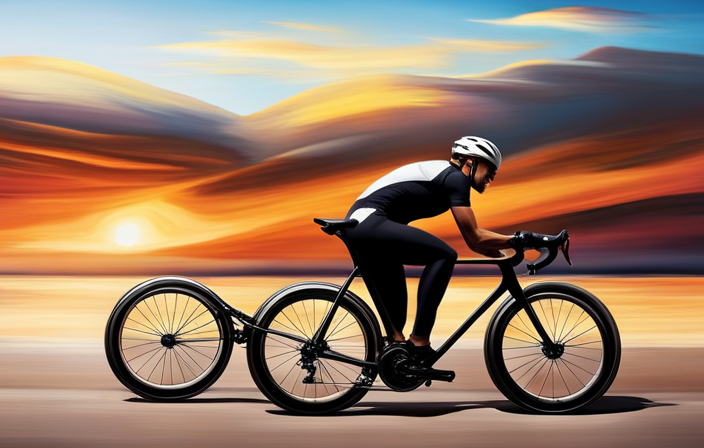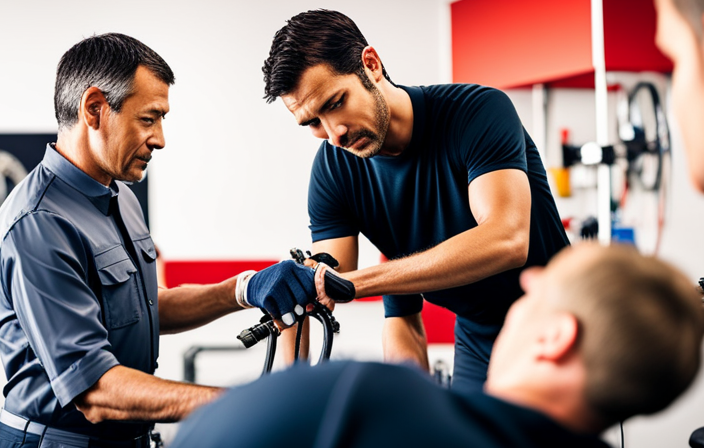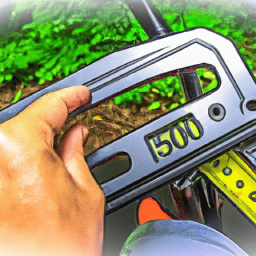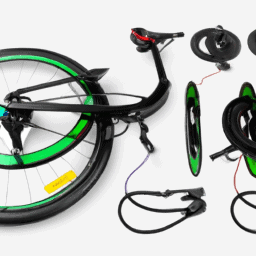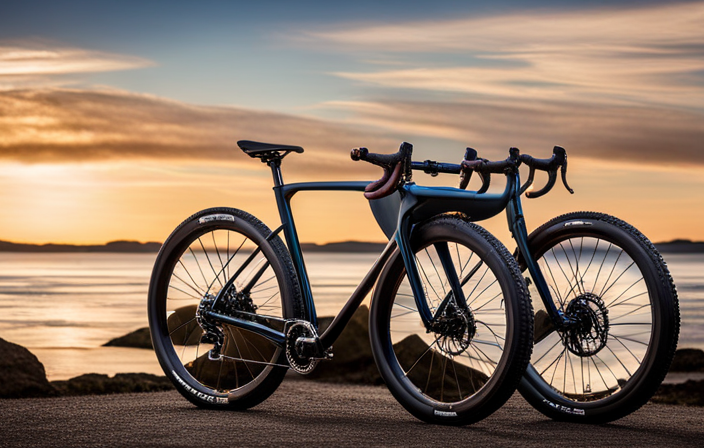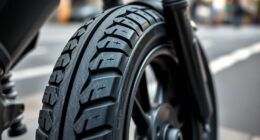Imagine being able to utilize the strength of a horse to move yourself ahead, with no requirement for fuel or emissions. That is precisely what a bicycle achieves.
In this article, we will explore the concept of horsepower and its application to bicycles. We will delve into the power output of human muscles, the factors that affect bicycle performance, and even compare bicycles to other modes of transportation.
Get ready to discover the true power of a bicycle and its impact on society.
Key Takeaways
- The horsepower of a bicycle is determined by the rider’s effort and can be measured using power measurement methods.
- Factors such as the rider’s fitness level, muscle strength, and efficiency, as well as the terrain, affect the bicycle’s performance.
- Bicycles require human power instead of fossil fuels, making them environmentally friendly and energy-efficient compared to cars and motorcycles.
- Advanced technology, such as lightweight materials, aerodynamics, electronic shifting systems, and power meters, can enhance bicycle performance and potentially lead to new speed records.
The Definition of Horsepower and Its Application to Bicycles
The horsepower of a bicycle is typically measured by the amount of effort the rider can exert. Power measurement is a crucial aspect when determining the horsepower of a bicycle.
Various calculation methods are used to quantify this power. One common method involves measuring the torque applied to the pedals and multiplying it by the angular velocity. Another method considers the force exerted on the bicycle and the speed at which it is moving. These calculations provide an estimation of the power output in watts.
It is important to note that the power output of human muscles greatly influences the horsepower of a bicycle. Understanding the capabilities of human muscles and their power output is essential in comprehending the overall performance of a bicycle.
The Power Output of Human Muscles
Human muscles can generate power when cycling. The power output of human muscles varies depending on various factors, such as the individual’s fitness level and muscle strength. On average, a trained cyclist can generate around 200-300 watts of power for an extended period of time. However, during short bursts of maximum effort, this power output can increase significantly, reaching up to 1000 watts or more.
Muscle efficiency also plays a crucial role in power output. Efficient muscles can convert a higher percentage of chemical energy into mechanical work, resulting in greater power output. Factors such as muscle fiber composition, muscle coordination, and fatigue resistance can affect muscle efficiency.
Understanding these aspects of human muscle power output and efficiency is essential for optimizing bicycle performance. Transitioning into the next section about factors affecting bicycle performance, it is important to consider not only the power output of muscles but also other key factors.
Factors Affecting Bicycle Performance
Factors affecting bicycle performance include the rider’s fitness level, muscle strength, and muscle efficiency.
A rider’s fitness level plays a crucial role in determining how efficiently they can pedal. A well-trained rider with high aerobic capacity can generate more power and sustain it for longer periods, resulting in improved bicycle performance.
Muscle strength is another important factor. The stronger the rider’s leg muscles, the more force they can apply to the pedals, resulting in increased speed and power output.
Additionally, muscle efficiency is crucial in determining how effectively the energy from the rider’s muscles is transferred into forward motion.
The terrain also plays a significant role in bicycle performance. Uphill climbs require more power output, while downhill descents allow for greater speeds with less effort.
These factors affecting bicycle efficiency and the impact of terrain on bicycle performance demonstrate the unique capabilities of bicycles compared to other modes of transportation.
Comparisons to Other Modes of Transportation
When comparing bicycles to cars and motorcycles, it is important to consider the horsepower of each mode of transportation.
Cars and motorcycles typically have significantly higher horsepower than bicycles, allowing them to achieve greater speeds and acceleration.
Additionally, the energy efficiency of bicycles is another key point of comparison, as they require human power to operate rather than relying on fossil fuels.
Bicycles are known for their high energy efficiency, making them a more environmentally friendly option for transportation.
Horsepower of Cars and Motorcycles
The horsepower of cars and motorcycles varies depending on the make and model. It is important to note that horsepower is a unit of measurement that quantifies the rate at which work is done.
In the case of cars, the horsepower can range from as low as 50 horsepower in compact cars to over 600 horsepower in high-performance sports cars. Motorcycles, on the other hand, generally have lower horsepower compared to cars, with an average range of 25 to 200 horsepower.
The development of horsepower in cars and motorcycles has seen significant advancements over the years, with manufacturers constantly pushing the limits to achieve higher power outputs. This historical development has led to the creation of incredibly powerful vehicles that can deliver impressive acceleration and top speeds.
Moving forward to the topic of energy efficiency of bicycles, it is interesting to explore how these vehicles compare in terms of power output and efficiency.
Energy Efficiency of Bicycles
After discussing the horsepower of cars and motorcycles, it is important to shift our focus to the energy efficiency of bicycles.
Bicycles are highly efficient machines that convert human energy into forward motion. Unlike cars and motorcycles, which are powered by fuel-burning engines, bicycles rely solely on the power generated by the rider’s legs. This makes them incredibly environmentally friendly, as they produce zero emissions and have no negative impact on air quality.
Additionally, cycling offers numerous health benefits, such as improved cardiovascular fitness, muscle strength, and mental well-being. Regular cycling can reduce the risk of heart disease, obesity, and other chronic conditions.
Transitioning to the next section, it is fascinating to explore the power output of professional cyclists and the incredible feats they achieve.
Professional Cyclists and Their Power Output
You can find professional cyclists and their impressive power output. These athletes are constantly pushing their bodies to the limit through specialized power training programs, meticulous nutrition plans, and a focus on performance optimization.
Power training plays a crucial role in developing the explosive leg strength required to generate high power outputs. Cyclists meticulously monitor their nutrition to ensure they have the necessary fuel for intense training sessions and races. Every aspect of their performance is meticulously analyzed and fine-tuned to maximize their power output on the bike.
Now, let’s transition into the subsequent section about the role of technology in enhancing bicycle performance.
The Role of Technology in Enhancing Bicycle Performance
Technology plays a crucial role in enhancing bicycle performance by providing cyclists with advanced tools and equipment. The continual advancements in technology have led to significant improvements in the overall performance of bicycles. From aerodynamic frames to lightweight materials, these technological innovations have allowed cyclists to achieve higher speeds and greater efficiency. One example of technology advancements in cycling is the development of electronic shifting systems, which allow for precise and seamless gear changes, resulting in improved power transfer and smoother pedaling. Additionally, the use of carbon fiber components has drastically reduced the weight of bicycles, enabling riders to accelerate faster and climb hills more efficiently. The integration of power meters and GPS devices has also allowed cyclists to monitor and analyze their performance, optimizing training and racing strategies. With these performance improvements brought about by technology, cyclists are now pushing the boundaries of human-powered speed records.
Subsequent section: ‘The Potential for Human-Powered Speed Records
The Potential for Human-Powered Speed Records
Imagine achieving new human-powered speed records with the advancements in biking technology. The potential challenges in setting new speed records lie in overcoming the limitations of the human body and pushing the boundaries of bicycle design.
Future advancements in materials and aerodynamics will play a crucial role in enhancing performance. For instance, lightweight carbon fiber frames and streamlined shapes can reduce drag and increase speed. Additionally, improvements in gearing systems and power transfer mechanisms can maximize the efficiency of pedaling.
It is an exciting time for the world of cycling as we explore new possibilities for human-powered speed. As we delve into the next section about interesting bicycle power facts and records, we will discover the astonishing achievements that have been made in the pursuit of speed.
Interesting Bicycle Power Facts and Records
When it comes to elite cyclists, their power output is truly remarkable. These athletes are able to generate an incredible amount of power, often reaching upwards of 2,000 watts during a sprint. This level of power is what allows them to achieve such high speeds and dominate in races.
In addition to the power output of cyclists, there are also some impressive records for the fastest human-powered vehicles. These vehicles, often streamlined and designed for speed, have reached speeds of over 80 miles per hour.
It’s truly fascinating to see what the human body is capable of when it comes to generating power and achieving incredible speeds.
The Power Output of Elite Cyclists
Elite cyclists typically have a power output of several hundred watts during intense races. Power output is a measure of how much work a cyclist can produce in a given time. To accurately measure power output, various techniques are used, such as using power meters that measure the force applied to the pedals and the cadence at which it is applied.
Additionally, physiological factors play a significant role in determining power output. Factors such as muscle strength, aerobic capacity, and efficiency of movement all contribute to a cyclist’s ability to generate power. Understanding these factors and optimizing them through training and conditioning can help elite cyclists maximize their power output.
Transitioning to the subsequent section, it is fascinating to explore the fastest human-powered vehicles and the incredible power they can generate.
The Fastest Human-Powered Vehicles
The fastest human-powered vehicles can reach incredible speeds through the power generated by their riders. These vehicles are designed to maximize efficiency and minimize drag, allowing riders to achieve astonishing land speeds. Here are some examples of the fastest human-powered vehicles:
-
The Aerovelo Eta: This streamlined bicycle holds the world record for the fastest human-powered vehicle, reaching a speed of 89.59 miles per hour (144.17 kilometers per hour).
-
The VeloX3: This recumbent bicycle achieved a top speed of 83.13 miles per hour (133.75 kilometers per hour) during the World Human Powered Speed Challenge.
-
The ARION4: Developed by students at the University of Liverpool, this handcycle reached a speed of 46.05 miles per hour (74.12 kilometers per hour) and set a new world record in the men’s handcycle category.
-
The Snowbird: This human-powered aircraft achieved the fastest human-powered flight speed of 7.71 miles per hour (12.4 kilometers per hour).
These vehicles demonstrate the incredible potential of human power in achieving remarkable speeds. Transitioning into the subsequent section about the benefits of human-powered transportation, it is clear that human power can not only deliver speed but also offer sustainable and eco-friendly solutions for transportation.
The Benefits of Human-Powered Transportation
You can experience numerous benefits from using human-powered transportation, such as a bicycle. Not only does it provide a sustainable mode of transportation, but it also offers a range of advantages for individuals and society as a whole. By pedaling a bicycle, you can improve your physical fitness, as it engages major muscle groups and increases cardiovascular endurance. Additionally, cycling can help reduce stress and improve mental well-being. Moreover, choosing a bicycle over a motorized vehicle contributes to a cleaner and greener environment, reducing air and noise pollution.
To illustrate the impact of human-powered transportation, consider the following table:
| Benefits of Human-Powered Transportation |
|---|
| Sustainable mode of transportation |
| Improved physical fitness |
| Reduced environmental impact |
In conclusion, the true power of a bicycle lies not only in its ability to transport individuals but also in its positive impact on society. Transitioning into the subsequent section, we will delve into the profound influence bicycles have had on our world.
Conclusion: The True Power of a Bicycle and its Impact on Society
Transitioning into the next section, we’ll delve into the profound influence bicycles have had on our world.
Bicycles have had a significant societal impact, shaping transportation, health, and the environment. They’ve revolutionized transportation by providing a cost-effective, efficient, and environmentally friendly alternative to cars. As more people choose bicycles over cars, congestion and pollution decrease, making cities more livable.
Additionally, cycling promotes physical activity, improving public health and reducing healthcare costs. With the increasing concern for climate change and sustainability, bicycles represent the future of human-powered transportation.
As technology continues to advance, we can expect even more innovative designs and features that enhance the cycling experience. From electric bicycles to smart bike-sharing systems, the future holds exciting possibilities for the continued growth and integration of bicycles into our society.
Frequently Asked Questions
What is the history of horse-powered transportation and its relation to bicycles?
During the industrial revolution, horse-drawn carriages were the primary mode of transportation. The advent of steam-powered engines and automobiles eventually replaced horses, leading to a decline in horse-powered transportation.
How do different terrains affect the horsepower output of a bicycle?
The effect of incline on the horsepower output of a bicycle is significant. As the terrain gets steeper, more power is required to overcome gravity. Additionally, the weight of the rider and the bicycle itself also impacts the overall horsepower output.
Are there any regulations or restrictions on the maximum horsepower a bicycle can have?
There are no specific regulations or restrictions on the maximum horsepower a bicycle can have. However, the measurement methods for determining horsepower may vary, with factors like rider effort and terrain affecting the overall output.
What are some common misconceptions about the power output of bicycles?
Common misconceptions about the power output of bicycles include underestimating their potential. While they lack traditional horsepower, their efficiency and muscle-like performance make them capable of impressive feats, far surpassing their modest appearance.
How does the power output of an electric bicycle compare to that of a traditional bicycle?
The power output of an electric bicycle is significantly higher compared to that of a traditional bicycle. This is because electric bicycles utilize a motor that provides additional power, resulting in improved efficiency and overall performance.
Conclusion
In conclusion, the power of a bicycle is truly remarkable. Through the power output of our muscles, a bicycle can generate an average of 0.1 to 0.3 horsepower. This may not seem like much compared to other modes of transportation, but it is enough to propel a person forward at impressive speeds.
It is fascinating to note that professional cyclists can generate up to 1.2 horsepower, showcasing the incredible strength and endurance of the human body.
With its numerous benefits, including environmental friendliness and health benefits, the bicycle continues to play a significant role in our society.
